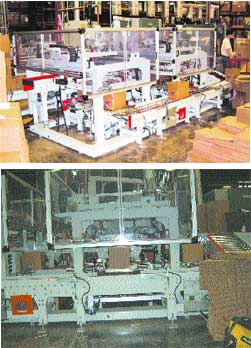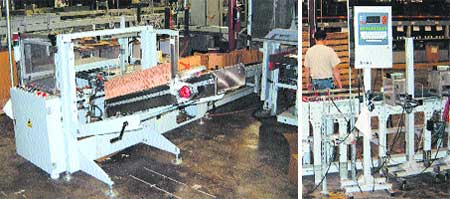January 29, 2014
|
Top, the robotic arm moves over the cases and fills them. The cases move to the outfeed conveyor and upstream to the weigher. Above, a cross-section view of the case packer as cases first enter the filling area. |
For every action, there is a reaction. At A Beka Book in Pensacola, FL, its bindery operations recently installed a 7,000-book/hr production line, and the reaction was a new turnkey case-packaging system. The book publisher produces Christian textbooks, teacher's aids, videos and support materials that are shipped worldwide through its Pensacola distribution center.
With A Beka's bindery operations producing 40,000 to 60,000 books/day, BestPack Packaging Systems designed an automated packaging system to accommodate the new book volume. BestPack developed a turnkey system solution for the high-volume bindery house last spring that features a fully automatic case erector, a conveyor system, robotics, a weigher, an ink-jet coder, a bar-code scanner and a uniform automatic case closer.
The packaging line begins with a vertical case erector, an E-LV-S 11-2, which features a magazine that can hold up to 100 knocked-down cases. The case flats move from the magazine to the case erector's forming area where opposed vacuum cups and an oscillating metal flange open cases at a rate of 15 to 18/min. After the cases are erected, a bottom seal is applied before they move to a conveyor connected to the machine.
The cases take two right turns on the conveyor before they enter the case-packing stations. There are two case-packing stations that are positioned parallel to a separate infeed book conveyor carrying book stacks into the packing area. The empty cases take a second right-hand turn onto an infeed conveyor that directs the cases to the two packing stations.
Before books are placed into an empty case, four vertical metal appendages descend from the case packer toward case's opening. The metal appendages push open the case's four flaps. The appendages perform three functions at this stage: opening the case's flaps, holding the case in place and creating a funnel for the books to pass through.
Challenges lie ahead
Manually inserting book stacks into empty cases was a huge problem for A Beka after it installed a bindery system that could produce 7,000 books/hr. An automated case-packing solution was needed. However, unique challenges had to be considered when designing the system.
|
Above left, the footprint size for the case erector is 81 x 74 x 54.6 in., and the magazine holds up to 100 flat cases. The ink-jet printer touchscreen, above right, allows operators to input changes for bar-code IDs, content descriptions, titles, quantities, dates and times that are printed on the cases. |
One of those challenges was thermal heat. The new high-volume binder created a large amount of thermal heat that could affect the visual presentation of the covers. So, a silicon spray was needed for the book covers. With the addition of silicone, the books became very slippery. Says David Lim, owner-engineer of BestPack, "The books are very slippery, and increasing the conveyor speed can cause shingling–the overlapping of books in a stack."
The book stacks are transferred in an efficient manner by two robotic arms. The two robotic arms, one for each packing station, have clamps to "pick up" the book stacks. Lim adds, "The book piles presented a very difficult challenge. The bindery house produces many different book sizes, from a pocketbook size to a directory/phone book size." During packing runs, the book stacks are uniform–same size books for one complete run. However, book sizes change for different runs.
Running parallel to the packing station is the bindery infeed conveyor, which delivers book stacks to a staging area, called the pedestal. The pedestal rises 6 in. for the robotic arm, and the clamps pick up both sides of the book stack.
From there, the gantry-designed robotic system transfers the book stacks approximately 10 ft to the packing station. With the case flaps opened and the funnel in place, the robotic arm releases books through the funnel/chute to the empty case. Lim says, "The slickness of the book stacks and the different box sizes made it a great challenge to fill these cases." A Beka runs 10 to 12 different box sizes, ranging from 9.25 to 12.25 in. in length and 7.5 to 9.25 in. in width.
For a new case size, the case erector is adjusted manually using built-in case presets, but the case packer automatically adjusts to the new case size with a touchscreen "keeping operator adjustments to a minimum during changeovers," says Lin.
Once the books are in place, the funnel releases the case to the outfeed conveyor and onto a shaker station. The shaker station utilizes turning square rollers on the conveyor to settle the books in the cases on-the-fly.
Case closed
The cases proceed downstream to a semi-automatic case closer, but before they reach their final destination, they pass through a weigher, an ink-jet coder and a bar-code scanner. This equipment is custom-built by BestPack, except for an ANSER printing system provided by Ariel Co. Intl. and a Datalogic, Inc. scanner. BestPack built the different packaging machines using various components from industrial suppliers.
The cases arrive at the weigher, and the machine determines if they are above or below the programmed weight. Ernest Tanksley, director of printing and shipping for A Beka, says, "The weigher equipment is sensitive enough to register a missing sixteen-page section from one of the books." While the weigher is not the centerpiece on this packaging line, it does provide vital quality control, PD is informed.
After they pass through the weigher, correctly filled cases reach the ink-jet printing system, where two high-resolution printheads transfer a bar-code ID, book description, title, quantity, date, time and an operator name onto cases. The weigher and ink-jet system "talk" to each other to communicate case weight information. Tanksley adds, "If a book is missing, then the case will not receive any coding information. The reject station will kick out the case."
After the ink-jet station, cases move to a scanner where the two lines of text and the bar-code ID are processed. The scanner checks for the proper bar code and plant information. If any of the information is incorrect or the bar code is not readable, the case is automatically rejected. The reject area is located immediately after the scanner station.
From there, the cases travel to the BestPack AS-22 automatic case closer that uses an integrated flap closer to close the flaps before it implements a top seal for the cases. The cases are manually placed on pallets and moved to A Beka's distribution center.
Many obstacles were presented in designing this packaging line, including building around an already present bindery production line. The turnkey system solution provided a clear design to overcome these many obstacles. The design took more than a year, and BestPack ran the system in its own warehouse before installing it at A Beka. In this situation, BestPack created an efficient packaging system, and the resulting reaction was a pleased customer.
More information is available:
Case erector, conveyor, case packer, weigher, case closer: BestPack Packaging Systems, 888/588-2378. Circle No. 215.
Ink-jet printer: ACI-Areil Co. Intl., 877/224-5678. Circle No. 216.
Scanner: Datalogic Inc., 800/626-3993. Circle No. 217.
About the Author(s)
You May Also Like




